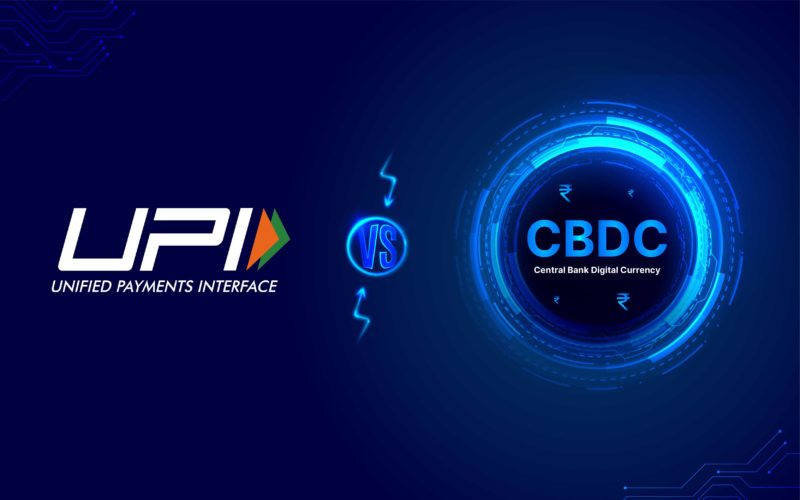The central bank digital currency (CBDC) and UPI are two different payment systems that have gained popularity in recent years. While the CBDC is a digital version of a country’s national currency that is issued and controlled by the central bank, UPI (Unified Payments Interface) is a real-time payment system that allows individuals to instantly transfer money between bank accounts using their mobile devices. This blog explains the key differences between CBDC and UPI and how they are used in the world of digital payments.
What is the Difference Between Central Bank Digital Currency (CBDC) and UPI?
Following is the difference between Central Bank Digital Currency and UPI:
Payment System:
- Central Bank Digital Currency (CBDC) is a digital version of a country’s national currency that is issued and controlled by the central bank.
- UPI (Unified Payments Interface) is a real-time payment system that allows individuals to instantly transfer money between bank accounts using their mobile devices.
Usage:
- CBDC stands for Central Bank Digital Currency and is a digital representation of a country’s fiat currency.
- CBDCs can be used by individuals and businesses to make digital payments.
- UPI stands for Unified Payments Interface and is a payment infrastructure that allows individuals to instantly transfer money between different bank accounts using their mobile devices.
Control by:
- CBDC stands for Central Bank Digital Currency and is issued and controlled by a country’s central bank.
- The central bank’s control over CBDC gives it the potential to be a more stable and secure form of digital payment.
- UPI stands for Unified Payments Interface and is controlled by a consortium of banks and financial institutions.
- Because it is not controlled by a single entity, UPI may not be as stable or secure as CBDC.
Acceptance:
- CBDC stands for Central Bank Digital Currency and is currently in the experimental phase.
- CBDC is not widely used at the moment.
- UPI stands for Unified Payments Interface and has gained widespread adoption in countries like India.
- UPI is used by millions of people for digital payments.
Monetary policy:
- CBDC (Central Bank Digital Currency) has the potential to change the way central banks manage the money supply and conduct monetary policy.
- UPI (Unified Payments Interface) has the potential to make digital payments more accessible and convenient for individuals and businesses.
How do Central Bank Digital Currency (CBDC) and UPI work?
CBDCs and UPI are digital payment systems that aim to improve efficiency and convenience. CBDCs are issued and regulated by central banks, while UPI is developed and managed by NPCI. Both systems use advanced technology like blockchain and cryptography to ensure transaction security and integrity.
CBDC (Central Bank Digital Currency)
- CBDCs are digital currencies issued by central banks and backed by the government
- They can be used for transactions like paying employees and purchasing goods and services
- Many countries are developing their own CBDCs with different features and functions
- CBDCs are similar to existing digital payment methods but without the need for multiple banks
- Transactions on CBDCs can be completed nearly instantly on a single digital ledger
- CBDCs can provide a way for unbanked individuals to transfer money digitally
Unified Payments Interface
- UPI is a digital payment system in India that allows for the transfer of money between bank accounts
- To use UPI, individuals must download a UPI-enabled app and link their bank account
- Users can generate a unique VPA and share it with the person they want to receive money from
- The sender can then use the VPA to transfer money to the receiver’s bank account, with the option to use a one-time password for added security
- UPI allows for real-time, instant transfers without the need for a physical check or bank draft
What are the Advantages and Disadvantages of UPI and Central Bank Digital Currency?
Unified Payments Interface
UPI, or Unified Payments Interface, is a system that allows for the seamless transfer of money between bank accounts in India. Some of the advantages of using UPI include its convenience, speed, and security. However, some potential disadvantages include the potential for technical issues and the need for a compatible device and bank account.
| Advantages of UPI |
|
| Disadvantages of UPI |
|
Central Bank Digital Currency
A central bank digital currency (CBDC) is a digital form of money issued by a central bank. It has several potential advantages, such as increasing financial inclusion and efficiency, and reducing the cost of printing and distributing physical money. However, it also has some potential disadvantages, such as the potential for increased surveillance and the potential loss of control over monetary policy.
| Advantages of CBDC |
|
| Disadvantages of CBDC |
|
Conclusion
In conclusion, CBDC is a digital form of fiat currency issued by a central bank, while UPI is a platform for electronic transactions using existing bank accounts. CBDC can be used as a means of payment and store of value, while UPI facilitates electronic transactions. CBDC is backed by the central bank, while UPI is not. Overall, the main difference between the two is that CBDC is a digital currency and UPI is a payment platform.




